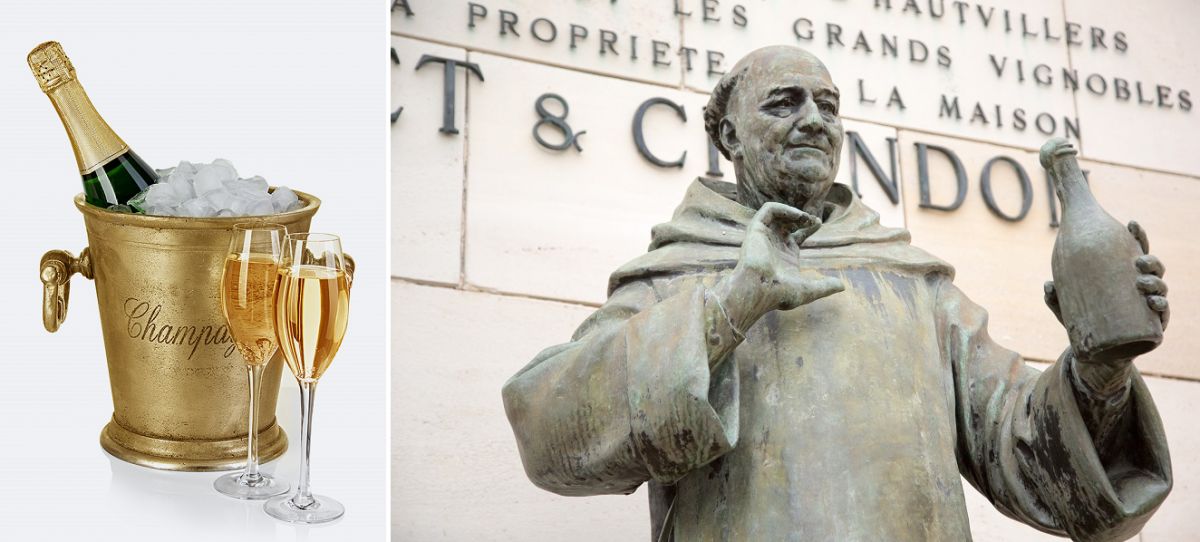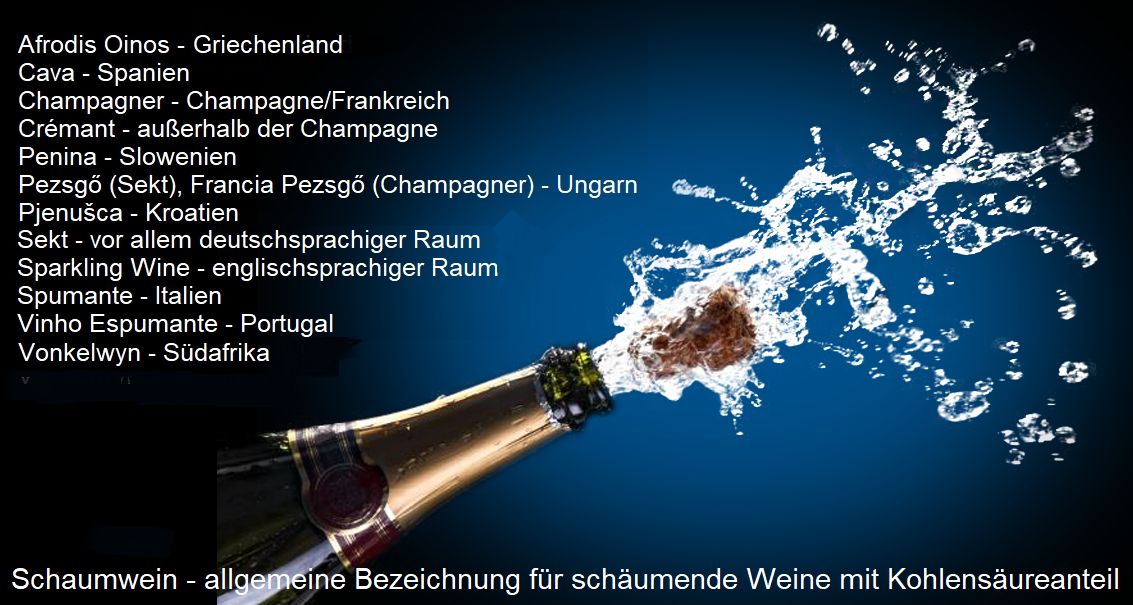Alternative French name (Champagne is common) for Champagne; see there.
Champagne (wine)
Sparkling wine from France is probably the most famous alcoholic beverage and epitomises joie de vivre and luxury. As early as 1531, a sparkling wine was documented in south-west France, namely the Blanquette de Limoux from the village of Limoux. But in Champagne, champagne was by no means synonymous with this type of wine in the first half of the 17th century. A common phenomenon in this region was that fermentation was interrupted in autumn due to the cool weather and the wines were bottled anyway. When the weather warmed up in spring, the residual sugar triggered an unplanned or unwanted second fermentation in the bottle. Initially, there was no intention behind it, it just happened by chance.

The "invention" of champagne
The deliberate production of champagne, i.e. the "invention" of the sparkling beverage, is often wrongly attributed to the Benedictine monk Dom Pierre Pérignon (1638-1715). A statuette of him stands in the headquarters of the largest champagne house Moët et Chandon in Épernay, which also produces a brand named after him. However, it is an indisputable fact that he brought the skilful blending of vintages, grape varieties and sites to perfection. But not only did he not aim for a second fermentation in the bottle, he also tried to prevent the undesirable process through various measures. One of these was to use more red wine grapes.
The satirist Marquis de Saint-Évremond (1610-1703), who went into exile in London due to disputes with the Prime Minister of Louis XIV (1638-1715), made an important contribution to its popularity. From 1661, he introduced white wines from Champagne in barrels. Due to the warm spring weather, a second fermentation was often started in the barrel. The lively, sparkling wines were bottled on arrival and quickly became a popular drink, especially in aristocratic circles. These were the primitive forerunners of champagne, twenty years before Dom Pierre Pérignon began to work on it. A "sparkling champagne" was first mentioned in writing in London in 1663. The first enthusiasts were therefore the English, and it was only afterwards that it became fashionable in France, especially in Paris.
In the last third of the 17th century, it became common practice in Champagne to add sugar and molasses to the wine during bottling in order to obtain sparkling and effervescent wines. The sparkling product was then deliberately produced in larger quantities towards the end of the century. However, even thick-walled bottles were very often unable to withstand the high carbon dioxide pressure caused by the copious addition of sugar and vigorous fermentation. Around 80% of all bottles were broken at the time. As a result, only a few thousand bottles were produced each year throughout the 18th century. And these were extremely expensive. For this reason, champagne initially developed exclusively as a fashionable drink in aristocratic circles or among the wealthy.
Large-scale production of champagne only began in the first third of the 19th century, when the problem of the correct sugar dosage was solved. The chemist Jean-Antoine Claude Chaptal (1756-1832) helped to clarify the issue. He recognised that the cause of foaming in the bottle was unfinished fermentation. However, the greatest achievement was made by the pharmacist Jean-Baptiste François (1792-1838), who discovered the secret of the correct amount of sugar. Other milestones were the improvement of corks, the corking machine and, at the Veuve Clicquot-Ponsardin Champagne House, the invention of the vibrating console for remuage by the legendary cellar master Antoine de Muller (1788-1859).
Region of origin
Champagne and the Champagne produced here enjoy the status of an Appellation d'Origine Protégée (AOP), even if this is not usually stated on the label. It is predominantly produced in white and in smaller quantities also as rosé, but there is no red as in the case of sparkling wine. According to the strict conditions of the CIVC, sparkling wine may only be called Champagne or Champagne) if it fulfils precisely regulated specifications regarding its origin. The grapes must be grown and pressed in the "Région délimitée de la Champagne viticole" and fermented in double fermentation according to the Méthode champenoise, which was established in 1935. This was laid down by an EU regulation in 1994 after endless legal disputes. Outside Champagne (and also in other countries), a quality sparkling wine is known as Crémant and in German-speaking countries as Sekt. The country-specific designations are:

The name Champagne is not only protected within the European Union, but in a total of 120 countries worldwide. In Russia, however, a law was passed in 2021 that the name "Champagne" may only be used for Russian sparkling wines. According to the new law, French champagnes must be labelled with the addition "sparkling wine". The word Champagne may only appear on the label in Latin and not in Cyrillic script. "Champagne" is now written in small letters on the back of the label.
Grape varieties
Seven varieties are authorised, of which only Pinot Noir, Pinot Meunier and Chardonnay play a role. The four varieties Arbane, Petit Meslier, Fromenteau (Pinot Gris ) and Pinot Blanc are authorised for historical reasons, but only occupy 90 hectares. Authorised training forms are Chablis, Cordon de Royat, Guyot and Vallée de la Marne. These are short prunings that guarantee moderate production. The maximum yield is set annually by the CIVC and depends on the weather and the economic situation. If there is an oversupply of Champagne, production is reduced. In 2019, this was 10,200 kg/ha of grapes (2018: 10,800 kg/ha).
Production of champagne
Champagne production is an extremely complex and complicated process. The chronicler Henry Vizetelly (1820-1894) described this in his book "A History of Champagne", published...
Voices of our members

Using the encyclopaedia is not only time-saving, but also extremely convenient. What's more, the information is always up to date.
Markus J. Eser
Weinakademiker und Herausgeber „Der Weinkalender“